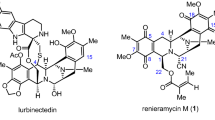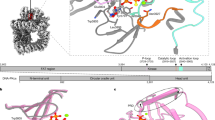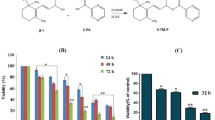Summary
PNU 151807 is a new synthetic α-bromoacryloyl derivative of distamycin A. In the present study we investigated the DNA interaction and the mechanism of action of this compound in parallel with the distamycin alkylating derivative, tallimustine. PNU 151807 possesses a good cytotoxic activity in in vitro growing cancer cells, even superior to that found for tallimustine. By footprinting experiments we found that PNU 151807 and tallimustine interact non-covalently with the same AT-rich DNA regions. However, differently from tallimustine, PNU 151807 failed to produce any DNA alkylation as assessed by Taq stop assay and N3 or N7-adenine alkylation assay in different DNA sequences. PNU 151807, like tallimustine, is able to induce an activation of p53, and consequently of p21 and BAX in a human ovarian cancer cell line (A2780) expressing wild-type p53. However, disruption of p53 function by HPV16-E6 does not significantly modify the cytotoxic activity of the compound. Flow cytometric analysis of cells treated with equitoxic concentrations of PNU 151807 and tallimustine showed a similar induction of accumulation of cells in the G2 phase of the cell cycle but with a different time course. When tested against recombinant proteins, only the compound PNU 151807 (and not tallimustine or distamycin A) is able to abolish the in vitro kinase activity of CDK2–cyclin A, CDK2–cyclin E and cdc2–cyclin B complexes. The results obtained showed that PNU 151807 seems to have a mechanism of action completely different from that of its parent compound tallimustine, possibly involving the inhibition of cyclin-dependent kinases activity, and clearly indicate PNU 151807 as a new non-covalent minor groove binder with cytotoxic activity against cancer cells.
Similar content being viewed by others
Article PDF
Change history
16 November 2011
This paper was modified 12 months after initial publication to switch to Creative Commons licence terms, as noted at publication
References
Beccaglia, P., Grimaldi, K. A., Hartley, J. A., Marchini, S., Broggini, M. & D’Incalci, M. (1996). DNA adduct formation of the sequence selective cytotoxic agent tallimustine resolved at the nucleotide level in a single copy gene in mammalian cells. Br J Cancer 73: 12
Bonfanti, M., Taverna, S., D’Incalci, M. & Broggini, M. (1997). p21 WAF-derived peptides linked to an internalization peptide inhibit human cancer cell growth. Cancer Res 57: 1442–1446.
Broggini, M., Erba, E., Ponti, M., Ballinari, D., Geroni, C., Spreafico, F. & D’Incalci, M. (1991). Selective DNA interaction of the novel distamycin derivative FCE 24517. Cancer Res 51: 199–204.
Broggini, M., Coley, H. M., Mongelli, N., Pesenti, E., Wyatt, M. D., Hartley, J. A. & D’Incalci, M. (1995). DNA sequence-specific adenine alkylation by the novel antitumor drug tallumustine (FCE 24517), a benzoyl nitrogen mustard derivative of distamycin. Nucleic Acids Res 23: 81–87.
Coley, H. M., Broggini, M. & D’Incalci, M. (1990). Studies of the novel distamycin compound FCE 24517 with respect to DNA interaction and sensitivity to alkylating agents. Br J Cancer 62: 506–500.
D’Alessio, R., Geroni, C., Biasoli, G., Pesenti, E., Grandi, M. & Mongelli, N. (1994). Structure activity relationship of novel distamycin A derivatives: synthesis and antitumor activity. Bioorganic Med Chem Lett 4: 1467–1472.
D’Incalci, M. (1994). DNA-minor groove alkylators, a new class of anticancer agents. Ann Oncol 5: 877–878.
D’Incalci, M. & Sessa, C. (1997). DNA minor groove binding ligands: a new class of anticancer agents. Exp Opin Invest Drugs 6: 875–884.
Drees, M., Dengler, W. A., Roth, T., Labonte, H., Mayo, J., Malspeis, L., Grever, M., Sausville, E. A. & Fiebig, H. H. (1997). Flavopiridol (L86-8275): selective antitumor activity in vitro and activity in vivo for prostate carcinoma cells. Clin Cancer Res 3: 273–279.
Geroni, C., Pesenti, E., Tagliabue, G., Ballinari, D., Mongelli, N., Broggini, M., Erba, E., D’Incalci, M., Spreafico, F. & Grandi, M. (1993). Establishment of L1210 leukemia cells resistant to the distamycin-A derivative (FCE 24517): characterization and cross-resistance studies. Int J Cancer 53: 308–314.
Ghielmini, M., Bosshard, G., Capolongo, L., Geroni, C., Pesenti, E., Torri, V., D’Incalci, M., Cavalli, F. & Sessa, C. (1997). Estimation of the haematological toxicity of minor groove alkylators using tests on human cord blood cells. Br J Cancer 75: 878–883.
Hartley, J. A., Gibson, N. W., Kohn, K. W. & Mattes, W. B. (1986). DNA sequence selectivity of guanine-N7 alkylation by three antitumor chloroethylating agents. Cancer Res 46: 1943–1947.
Hartley, J. A., Lown, J. W., Mattes, W. B. & Kohn, K. W. (1988). DNA sequence specificity of antitumor agents. Oncogenes as possible targets for cancer therapy. Acta Oncol 27: 503–510.
Hertzberg, R. P. & Dervan, P. B. (1984). Cleavage of DNA with Methidiumpropyl-EDTA-Iron(II): reaction conditions and product analyses. Biochemistry 23: 3934–3945.
Hurley, L. H., Reynolds, V. L., Swenson, D. H., Petzold, G. L. & Scahill, T. A. (1984). Reaction of the antitumoral antibiotic CC-1065 with DNA: structure of DNA adduct with sequence specificity. Science 226: 843–844.
Lee, M., Rhodens, L., Wyatt, M. D., Forrow, S. & Hartley, J. A. (1993). Design, synthesis, and biological evaluation of DNA sequence and minor groove selective alkylating agents. Anticancer Drug Des 8: 173–192.
Li, L. H., Swenson, D., Schpock, S., Kuentzel, S., Dayton, B. & Kreiger, W. (1982). CC-1065 (NSC-298223) a novel antitumour agent that interacts strongly with double-stranded DNA. Cancer Res 42: 999–1004.
Li, L. H., Dekoning, T. F. & Kelly, R. C. (1992). Cytotoxicity and antitumor activity of carzelesin, a prodrug cyclopropylpyrroloindole analogue. Cancer Res 52: 4904–4913.
Marchini, S., Gonzales Paz, O., Ripamonti, M., Geroni, C., Bargiotti, A., Caruso, M., Todeschi, S., D’Incalci, M. & Broggini, M. (1995). Sequence-specific DNA interactions by novel alkylating anthracycline derivatives. Anticancer Drug Des 10: 641–653.
Marchini, S., Cozzi, P., Beria, I., Geroni, C., Capolongo, L., D’Incalci, M. & Broggini, M. (1998). Sequence specific DNA alkylation of novel tallimustine derivatives. Anticancer Drug Des 13: (in press)
Mattes, W. B., Hartley, J. A. & Kohn, K. W. (1986). DNA sequence selectivity of guanine-N7 alkylation by nitrogen mustards. Nucleic Acids Res 14: 2971–2987.
Ponti, M., Forrow, S. M., Souhami, R. L., D’Incalci, M. & Hartley, J. H. (1991). Measurement of the sequence specificity of covalent DNA modification by antineoplastic agents using Taq DNA polymerase. Nucleic Acids Res 19: 2929–2933.
Reynolds, V. L., Molineux, I. J., Kaplan, D. J., Swenson, D. H. & Hurley, L. H. (1985). Reaction of the antitumor antibiotic CC-1065 with DNA. Location of the site of thermally induced strand breakage and analysis of DNA sequence specificity. Biochemistry 24: 6228–6237.
Sambrook, J., Fritsh, E. & Maniatis, T. (1989). Molecolar Cloning: A Laboratory Manual, Cold Spring Harbor, NY: Cold Spring Harbor Laboratory Press
Sessa, C., Pagani, O., Zurlo, M. G., Jong, D. E., Hoffmann, C., Lassus, M., Marrari, P., Strolin,, Benedetti, M. & Cavalli, F. (1994). Phase I study of the novel distamycin derivative tallimustine (FCE 24517). Ann Oncol 5: 901–907.
Sun, D. & Hurley, L. H. (1992). Effect of the (+)-CC-1065-(N3-adenine) DNA adduct on in vitro DNA synthesis mediated by Escherichia coli DNA polymerase. Biochemistry 31: 2822–2829.
Tishler, R. B., Lamppu, D. M., Park, S. & Price, B. D. (1995). Microtubule-active drugs taxol, vinblastine, and nocodazole increase the levels of transcriptionally active p53. Cancer Res 55: 6021–6025.
Vikhanskaya, F., Erba, E., D’Incalci, M. & Broggini, M. (1994). Introduction of wild-type p53 in human ovarian cancer cell line not expressing endogenous p53. Nucleic Acids Res 22: 1012–1017.
Vikhanskaya, F., Vignati, S., Beccaglia, P., Ottoboni, C., Russo, P., D’Incalci, M. & Broggini, M. (1998). Inactivation of p53 in a human ovarian cancer cell line increases the sensitivity to paclitaxel by inducing G2/M arrest and apoptosis. Exp Cell Res 241: 96–101.
Author information
Authors and Affiliations
Rights and permissions
From twelve months after its original publication, this work is licensed under the Creative Commons Attribution-NonCommercial-Share Alike 3.0 Unported License. To view a copy of this license, visit http://creativecommons.org/licenses/by-nc-sa/3.0/
About this article
Cite this article
Marchini, S., Cirò, M., Gallinari, F. et al. α-Bromoacryloyl derivative of distamycin A (PNU 151807): a new non-covalent minor groove DNA binder with antineoplastic activity. Br J Cancer 80, 991–997 (1999). https://doi.org/10.1038/sj.bjc.6690453
Received:
Revised:
Accepted:
Published:
Issue date:
DOI: https://doi.org/10.1038/sj.bjc.6690453
Keywords
This article is cited by
-
Brostallicin (PNU-166196) – a new DNA minor groove binder that retains sensitivity in DNA mismatch repair-deficient tumour cells
British Journal of Cancer (2003)



